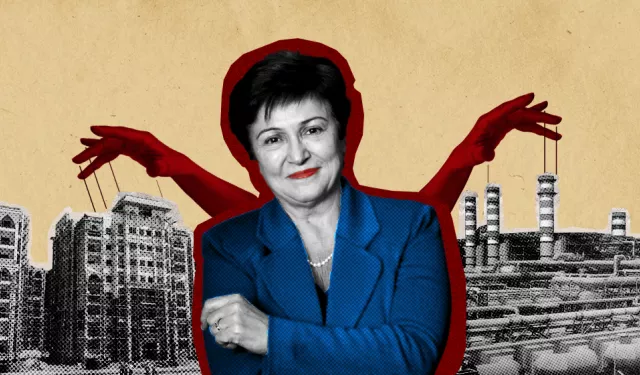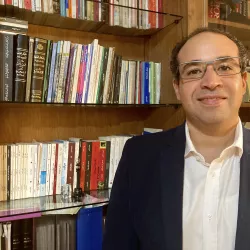
The IMF’s half truths
When the International Monetary Fund/IMF decided to delay the fifth review of its loan to Egypt, my thoughts inexplicably turned to a lengthy Hadith of the Prophet Muhammad. The lengthy narrative ends with the Prophet explaining how Satan, a habitual liar, did once speak the truth.
To justify the delay, the IMF cited concerns over the state's crowding out of the private sector—an issue that has drawn repeated criticism in recent years. The narrative in Egypt now suggests that the construction of highways, bridges, and new cities has devoured the private sector’s share of the economic pie.
However, the reality is far more sobering.
Both the private sector and the state have shown severely weak levels of investment in recent years. Ironically, that weakness in both arenas may be the result of the IMF’s own reform prescriptions.
Private sector under pressure?
There’s no denying that pressure on the private sector presents a serious problem, since it contributes roughly 70% of Egypt’s GDP and provides about 80% of jobs. In simple terms, crowding out the private sector means choking the majority of the Egyptian economy.
The IMF also appears to be telling the truth when it points to a decline in private sector participation.
If we measure in terms od gross fixed capital formation (GFCF)—investment in fixed capital such as production equipment—we will find that, in 2024, Egypt hit its lowest level since 1980 as a share of GDP. This decline was significantly influenced by the private sector's share, which stood at a mere 5% of GDP last year.
For context, the average GFCF in middle-income countries is 31%, while South Asia averages 26% and East Asia 35% (excluding high-income nations).
This drop in private sector investment reflects a decade-long trend in Egypt. It initially rose from 7.26% in 2014 to peak at 9.3% in 2019, before steadily declining to 6.55% in 2023, and ultimately reaching 5% in 2024.
However, the challenge isn't confined to the private sector alone. From 2014 to 2024, Egypt's average GFCF, encompassing both private and public investment, was just 15.65% of GDP—a meager figure compared with other middle-income countries, and well below the 19.19% average during the government of Ahmed Nazif (2004–2010).
Looking further back, Egypt’s average GFCF between 1982 and 2010 also surpassed current levels. In essence, the country is now grappling with its lowest investment levels in decades.
What’s behind the decline?
The IMF’s honesty ends here.
The Fund builds its narrative on the idea that Egypt’s private sector has lost interest in—or the ability to engage in—investment primarily because of state encroachment through its own investment spending. This is what many people see in the visible boom in bridges, roads, construction, and housing projects.
Yet when viewed as a percentage of GDP, public investment remains modest.
The IMF ignores—or deliberately overlooks—other influential factors that continue to weigh heavily on private investment. Chief among them is the severe volatility in macroeconomic indicators such as soaring inflation rates, and repeated, sharp devaluations of the Egyptian pound against the US dollar.
More importantly, Egypt faces persistently high real interest rates—an IMF-backed measure intended to fight inflation and attract “hot money” (short-term speculative capital). Since 2016, every IMF program with Egypt has followed the logic of facilitating more external borrowing through high-yield instruments.
So, when the Fund brings up “crowding out,” I wish I could ask: How exactly does chronic and excessive interest rate hiking support investment?
Floating the pound & interest rates
High interest rates simply mean high borrowing costs, which makes it more difficult for both households and businesses to spend or invest.
Similarly, exchange rate volatility creates uncertainty in accessing imports. More crucially, these twin sources of instability—interest and exchange rate fluctuations—undermine the ability to make long-term decisions. And investment, by nature, is spending money now in pursuit of returns later.
That may help explain why Egypt’s average annual growth in fixed capital formation (i.e. investment spending) between 2014 and 2024 was a mere 3.44%. By comparison, the Nazif government (2004–2010) saw this figure average a robust 17.3%.
Yes, parts of the state apparatus may be crowding out the private sector, but there’s no logical basis for treating that as the sole—or even the primary—reason for the decline in private investment.
Such framing conveniently ignores the wider macroeconomic disarray, which, at best, was enabled by the IMF’s own inconsistent prescriptions.
These so-called reforms haven’t just hurt the private sector. They’ve also contributed to rising poverty rates and deep cuts in public spending on health, education, and social protection—all in the name of austerity mandated by the IMF.
Also worth noting is that the Fund never seems to consider the state’s domination of bank financing as a form of crowding out. The government now claims the lion’s share of bank loans to finance public debt. This trend has only intensified in recent years, as debt servicing has grown into the single largest item in Egypt’s national budget—driven, once again, by rising interest rates.
Naturally, the IMF doesn’t seem too bothered by this. After all, it routinely praises Egypt for generating a “primary surplus”—a sanitized term that really means diverting funds from essential government services to repay debt principal and interest.
The bottom line is that the IMF is not entirely wrong to highlight the problem of falling private investment in Egypt. It is, however, disingenuous—perhaps deliberately so—to pin that decline solely on “state crowding out.”
By doing so, it ignores the broader economic turmoil that it helped create—or at the very least, failed to resolve—through a decade of interventions.
